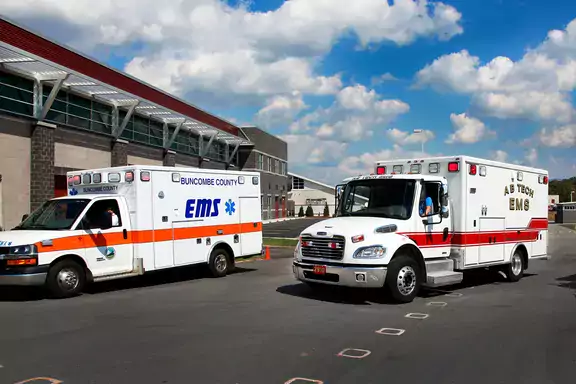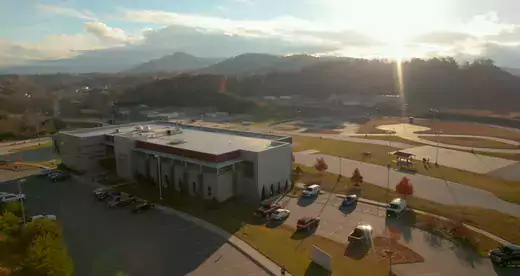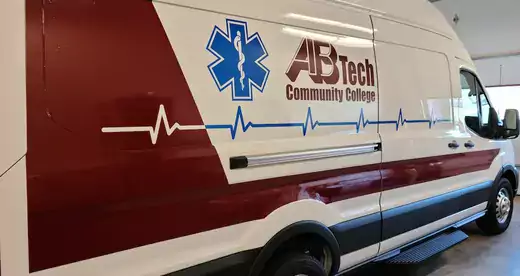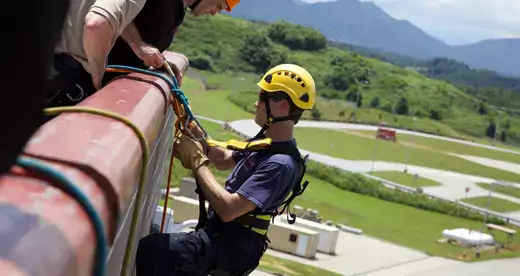Programs
| Title | Credential | Credit Hours | Link to program details |
|---|---|---|---|
| Emergency Medical Science A.A.S. | Degree | 74 | |
| Emergency Medical Science Bridge Program | Degree | 29 | |
| Basic Emergency Medical Science Certificate | Certificate | 16 | |
Career Opportunities
Employment of emergency medical technicians (EMTs) and paramedics is projected to grow 7 percent from 2018 to 2028, faster than the average for all occupations. Emergencies, such as car crashes, natural disasters, and acts of violence, will continue to require the skills of EMTs and paramedics.
(Source: U.S. Bureau of Labor Statistics)
Good to Know
Prospective Students for the Emergency Medical Science Curriculum
- What is a Paramedic?
- Levels of Credentials
- Entrance Requirements
- Steps for Entering the EMS Program
- Course Schedule
- Clinical Requirements
- Uniform Requirements
- Background Checks
What is a Paramedic?
The term paramedic comes from para- (auxiliary) + medical, meaning "related to medicine in an auxiliary capacity," the military term paramedic, meaning a parachuting medical corpsman, came later.
Paramedics are highly trained medical professionals who function in various austere environments. They must be well versed in a variety of specialties. Paramedics must also be prepared to handle themselves in a situation that is presented. This includes rescue skills, knowledge of fire scene operations, hazardous materials response, vehicle extrication, and self-defense.
One benefit of being a paramedic is that you always are doing something different. No two emergency calls are exactly alike.
A paramedic is charged with providing emergency on-scene treatment, crisis intervention, life-saving stabilization, and transport of ill or injured patients to definitive emergency medical and surgical treatment facilities, such as hospitals and trauma centers.
The use of the specific term paramedic varies by jurisdiction, and in some places is used to refer to any member of an ambulance crew. In countries such as Canada and South Africa, the term paramedic is used as the job title for all EMS personnel, who are then distinguished by the terms primary or basic (e.g. Primary Care Paramedic) intermediate, or advanced (e.g. Advanced Care Paramedic). This approach may be completely appropriate in such jurisdictions, where primary care staff receive more than double the classroom and clinical training of an EMT, and in fact more than those in some jurisdictions permitted by law to call themselves paramedics. In countries such as the United States and the United Kingdom, the use of the word paramedic is restricted by law, and the person claiming the title must have passed a specific set of examinations and clinical placements, and hold a valid registration, certification, or license with a governing body. Even in countries where the law restricts the title, laypersons may incorrectly refer to all emergency medical personnel as 'paramedics', even if they officially hold a different qualification, such as emergency medical technician-basic.
Once a person is credentialed as a paramedic they are then able to train to gain other specialties. Examples of these are rescue teams, supporting law enforcement, wildland fire suppression, critical care, incident command, and many more. Many of these will test paramedics' skills due to the complex setting they are placed into.
Most paramedics are employed by an emergency medical services (EMS) system. This can be a county ran the system, a private ambulance system, or a regional system. Some paramedics are also firefighters and work for a fire department. In other areas of the country, paramedics are employed by law enforcement agencies.
Paramedics perform advanced procedures such as endotracheal intubation, surgical airways, chest needle decompression, medication administration, IV fluid resuscitation, etc. They learn to operate many types of advanced equipment such as cardiac monitors, 12-lead EKG machines, defibrillators, capnometers, and external pacemakers.
Levels of Credentials in North Carolina
There are four main levels of credentials for emergency responders in NC. The following list is the credentials in order of lowest to highest.
- Emergency Medical Responder (EMR)
Common level for volunteer firefighters and some law enforcement officers. - Emergency Medical Technician (EMT)
Your first semester at ABTECH will prepare you for this level. The common level of certification for firefighters, camp counselors, rescue workers, and the general public. - Advanced EMT (AEMT)
Common level for beginning certification to work on an advanced life support ambulance. This level allows them to start IVs and give some medications. Your second semester will prepare you for this level. - Paramedic
Highest level of emergency care outside of a hospital. Your last three semesters will focus on this level of advanced care.
Specific Entrance Requirements
The following list is requirements that must take place prior to your entrance into the EMS Program.
You should:
- Have graduated from high school and have a transcript, or GED scores are on file with the Admissions Office
- Be 18 years of age or older by the end of the first semester
- Possess a valid North Carolina driver's license
- Pass a physical exam by a physician
- Have proper immunization records
Steps for Entering the EMS Program
EMS is located at A-B Tech Woodfin and has some specific requirements set by the NC Office of EMS and other organizations. Contact one of the EMS department advisors for important information and with questions about the application process.
- Complete an application for admission into the College.
- Turn in a high school transcript or GED scores to the Admissions Office.
- Turn in any transcripts from previous colleges to the Admissions Office.
- You will be contacted by phone and email regarding an introduction and orientation session for the EMS Program.
- Be sure to attend the introduction and orientation session for the program. Your seat may be given to another student if you do not attend.
- Complete all paperwork that you receive in orientation as soon as possible.
- Pay your tuition. The College refund policy applies if a student drops the program after being denied clinical site privileges.
- Purchase all of your required textbooks, which you can look up at the Book Store.
- Obtain a parking decal and place it correctly on your vehicle. You can park in the white-lined spaces only.
- Be present on the first day of class at the indicated time. Parking is difficult, so plan to arrive at least 20–30 minutes prior to your class time.
- Have class supplies such as paper, pens, and pencils for taking notes.
- Turn in the health form that you received in the mail or at orientation.
- Prepare to purchase uniforms.
Clinical Requirements
Students who are entering the EMS Program with the aspiration of becoming a paramedic should understand that their training is not completely in the classroom. Clinical is a course that places students at various agencies to allow paramedic interns to gain exposure to real-life situations. Each student will complete the EMS Program with at least 500 hours of clinical time logged. Many students earn 1,000 or more clinical hours. We encourage students to actively pursue as much clinical time as possible.
Some examples of the places you may attend clinical:
- Asheville VA Medical Center Operating Rooms
- Buncombe County EMS
- Various Buncombe County Fire Departments EMS (Barnardsville, Reems Creek, Riceville, Skyland)
- Haywood County EMS
- Henderson County EMS
- Madison County EMS
- Medical Emergency Transport Services
- Mission Hospitals Emergency Departments
- Medical Director Rotations in Emergency Departments
- Mission Hospitals Neuro-Trauma Intensive Care Unit
- Mission Hospitals Cardiac Cath Lab
- Mission Hospitals Post Anesthesia Care Unit (PACU)
- Reuter Children's Outpatient Center
- Mission Hospitals Cardiovascular Intensive Care Unit
- Mission Hospitals Labor and Delivery
- Mission Hospitals Pediatric Intensive Care Unit
- Mission Hospitals Neonatal Intensive Care Unit
- Mission Hospitals Regional Transport Services
- Grady EMS, Atlanta GA
- McDowell County EMS
- Yancey County EMS
- NC Mountain State Fair
The times for clinical activities vary from early morning rotations to late evening rotations. Most of our clinical rotations will be on Tuesday, Thursday, or Friday. However, other days of the week are scheduled as the need arises. Clinical shifts are scheduled for at least nine hours. Tuesday and Thursday clinical shifts usually run from 1:00 p.m. to 10:20 p.m. Friday clinical shifts usually run from 8:00 a.m. to 5:20 p.m.
Clinical begins in the second semester of the EMS Program. This semester is focused on orientation and Advanced EMT skills. 96-hours of clinical must be obtained in that semester.
The students become Paramedic Interns in their third semester here at A-B Tech. Clinical begins to focus on advanced level care. A total of 500-hours is required by North Carolina during the final three semesters. This equates to a 167-hours minimum during each of the final three semesters.
Grady EMS in Atlanta, Georgia is an example of an overnight trip that actually lasts for five consecutive days. This occurs during the second fall semester of your EMS Program. Please be prepared for this trip.
Uniform Requirements
Students in the EMS are required to begin the purchase of uniforms during their first semester.
We ask that you purchase the pants, boots, belt, and t-shirts as soon as financially possible. This will be your recommended daily attire. The uniform shirt with patches and name bar will be purchased at a later date near the end of the first semester.
Background Checks
The EMS Department of A-B Tech does not handle this process. Clinical sites have the right to require students and interns to complete a criminal history background check. Their discretion determines if the student or intern is allowed to function at their facility or agency. A national criminal background check is required to be completed before you begin clinical rotations. This will be handled directly between the student and the clinical agency. The College refund policy applies if a student drops the program after being denied clinical site privileges.
The North Carolina Office of EMS will also require a background check before credentialing an individual. This may require a student to complete additional paperwork, explain their situation by telephone, or even be present at a disciplinary panel hearing in Raleigh, NC. A student will not be allowed to begin clinical rotations until they are cleared from the OEMs and are credentialed at a minimum of EMT.
The EMS Department is located at A-B Tech Woodfin at 24 Canoe Lane, Asheville, NC 28804
Please Email Cindy Ingle Emergency Services Administrative Assistant at cynthiaringle@abtech.edu
or call her at (828) 782-2355, to make an appointment to speak with one of the EMS Advisors.
Our mailing address is:
A-B Tech EMS Department
340 Victoria Road
Asheville, NC 28801
- North Carolina Office of EMS
- Buncombe County EMS
- Henderson County EMS
- Asheville Fire and Rescue
- Mission Hospitals
- Swannanoa Fire and Rescue
- Enka-Candler Fire and Rescue
- Reynolds Fire Department
- Skyland Fire Department
- West Buncombe Fire and Rescue
- Weaverville Fire Department
- Black Mountain Fire Department
- Leicester Fire Department
- Buncombe County Sheriff's Office
- Asheville Police Department
- North Carolina Highway Patrol
- Grady Health System
- EMS Division of the National Highway Traffic Safety Administration
- North Carolina College of Emergency Physicians (NCCEP)
- National Association of EMS Physicians
- North Carolina Association of Rescue and EMS
- North Carolina EMS Training Calendar
- North Carolina Community College Distance Learning Course Search
- Southern Regional Distance Learning Course Search
- FlightWeb
- Adobe Reader - Free Download
Anthony Green, Chair of Emergency Medical Science
- Email: anthonytgreen@abtech.edu
Brian Newsom, Emergency Medical Science Instructor
- Email: charlesbnewsom@abtech.edu
Whitney Al-Khatib, Emergency Medical Science Clinical Coordinator
- Email: whitneyjalkhatib@abtech.edu
Dr. Stace Horine, Emergency Medical Science Medical Director
Yes. Many students do work while they attend school. Most who choose to work do so on a part-time basis. Many employers are willing to work with your schedule while you attend school.
The Admissions Office has information on tuition and associated expenses. The College refund policy applies if a student drops the program after being denied clinical site privileges.
The cost of textbooks varies from year to year. We try to keep the cost as low as possible, but it is still sometimes a formidable amount. A student taking a full load should expect a $400 expense for each semester. Our program attempts to use the same textbook in multiple semesters when possible, which minimizes the expense.
The yearly salary of paramedics varies greatly depending on the agency who they work for and the schedule. The highest in the Asheville area is Buncombe County EMS. They hire new paramedics at approximately $45,000 per year. They work a schedule where paramedics are on duty for 24-hours and then have 48-hours off.
Yes. Many of our students begin to work in emergency services after they successfully become credentialed as an EMT or AEMT. Some employers will work with your schedule to allow you to complete the program and function as a paramedic.
We do not require you to graduate with an associate degree to be eligible to test for your credentials. You must successfully complete all of the EMS major courses including pre-requisites and co-requisites to be eligible to test for a paramedic. The length of the classes involved is the same. It simply lightens your class load during your time.
The time saved by not taking these general education courses is not worth bypassing the degree. It is well worth your time to go ahead and take the additional classes to get a degree. Most students take these general education courses together and build stronger relationships.
This is often confusing for many people. Most EMT classes are offered through continuing education or occupational extension training. This is different from curriculum classes where college credit is achieved. In order for an EMT class to transfer it must be recent and have received credit for 8 semester credit hours.
EMT certification alone does not exclude you from the first semester. If you have successfully completed an EMT course in the past year and have your North Carolina EMT credentials you may ask the department chair for the possibility of challenging the final exam once you have enrolled in the course. This is not usually recommended because you are not as likely to succeed. See page 27 in the college catalog for transfer information.
The EMS Program is a very challenging course for the majority of people. You will have to study diligently and practice skills outside of class time in order to be proficient. Across the nation, most paramedic programs have at least a 50% rate of attrition. You are expected to learn a vast amount of material to prepare you to function independently while taking care of critical patients. This responsibility makes your education crucial.
Clinical is a very unique experience that gives our students exposure to the world of EMS. You will assist with actual live patient care in a variety of settings. This can be stressful when placed in situations that are chaotic and sometimes dangerous. You may be delivering a baby one moment or responding to a violent crime the next. You are always monitored by a preceptor so you are never truly alone. Clinical provides learning opportunities that are not possible in a classroom environment.
Students must be in at least average shape to do well in the EMS Program. Training to become a paramedic requires you to walk distances carrying a weight of up to 50 pounds. Paramedics are required to move patients who are unable to move. Being a field paramedic is a physical career. You should be capable of climbing flights of stairs without becoming extremely short of breath. The skills require you to be able to get down on the ground and back up rapidly. Most EMS agencies conduct a physical assessment as a condition of employment.
You will need to have some form of transportation. There is no public transportation to the A-B Tech Woodfin and is not guaranteed to all clinical sites.
Paramedics work a variety of schedules just like employees for places of business. Predominantly their schedule is a 24/48 shift. This means you go to work for a straight 24-hour shift. After you complete the shift you have 48 hours off.
For example, Paramedic Smith reports to work on Monday morning. He will get off work on Tuesday morning. Then has to report again on Thursday morning. This averages out to be a 56-hour workweek. One week will be 48-hours and the next week will be 72-hours.
Another common schedule is the "DuPont" schedule which utilizes 12-hour shifts. The shifts rotate between days and nights and give you a seven-day stretch off each month.
Large services may offer a variety of shifts for their employees. You could choose to work 24, 13, 12, 10, or 8-hour shifts. This is a big consideration when you are considering where to work.
Yes. The college and the North Carolina Office of EMS both require a 90% attendance policy. That means you may be absent from class up to 10% for an excused absence as long as you make up the time missed. Examples of excused absences are serious illness, death in the family, inclement weather, and military responsibilities. 10% of most of the EMS courses equate to one whole class missed each semester. It is vital that you are in class every time it meets.
The A-B Tech paramedic program is accredited by the Commission on Accreditation of Allied Health Education Programs upon the recommendation of the Committee on Accreditation of Educational Programs for the Emergency Medical Services Professions (CoAEMSP)
Commission on Accreditation of Allied Health Education Programs
9355 - 113th St. N, #7709
Seminole, FL 33775
- Phone: (727) 210-2350
Committee on Accreditation of Educational Programs for the Emergency Medical Services Professions (CoAEMSP)
8301 Lakeview Parkway Suite 111-312
Rowlett, TX 75088
- Phone: (214) 703-8445
- FAX: (214) 703-8992
- Website: CoAEMSP
The Student Paramedic Association (SPA) is a chartered body that is set forth to provide a means for students to help the college, the community, and training not paid for by the school. Each student is required to participate in the SPA in order to be eligible to receive funding.
Here are a few examples of how the SPA has used its funding:
- Providing food and lodging for a five-day internship at Grady Memorial Hospital in Atlanta, Ga.
- Assisting with the cost of the students' graduation ceremony.
- Providing assistance to fellow emergency services workers in times of hardship.
- Giving underprivileged children a Christmas Party and presents who otherwise would not receive anything.
Fundraising Events
- Car wash
- Car Show
- Candle sales
- Raffle
- Calendar sales
- Candy sales
- Yard sales
Officers
- President
- Vice President
- Treasurer
- Secretary



